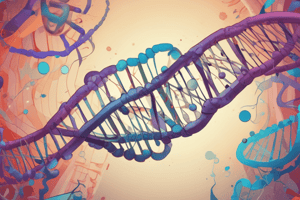Podcast
Questions and Answers
What carries hereditary information?
What carries hereditary information?
Chromosomes
What are the two types of nitrogenous bases in DNA?
What are the two types of nitrogenous bases in DNA?
- Ribose
- Nucleotides
- Purines (correct)
- Pyrimidines (correct)
A and T have three hydrogen bonds.
A and T have three hydrogen bonds.
False (B)
The bond between the phosphate group of one sugar and the hydroxyl group of another sugar is called a ______.
The bond between the phosphate group of one sugar and the hydroxyl group of another sugar is called a ______.
What is the role of the nuclear envelope?
What is the role of the nuclear envelope?
Which of the following describes chromatin?
Which of the following describes chromatin?
What are gametes?
What are gametes?
What is a karyotype?
What is a karyotype?
Introns are the coding regions of a gene.
Introns are the coding regions of a gene.
What type of sequence codes for centromeres?
What type of sequence codes for centromeres?
What is the function of telomeres?
What is the function of telomeres?
Flashcards are hidden until you start studying
Study Notes
Heredity and DNA
- Genes, composed of DNA, contain instructions for a species' characteristics.
- Hereditary information is carried on chromosomes, made of DNA and proteins.
- DNA strands have opposing directions (5' phosphate end, 3' hydroxyl end).
- Adenine (A) pairs with Thymine (T) via two hydrogen bonds, while Cytosine (C) pairs with Guanine (G) via three hydrogen bonds.
- Purines (A and G) are larger, with two rings, while pyrimidines (C and T) are smaller, with one ring. This ensures consistent base pair width.
- A phosphodiester bond links one sugar to the next, connecting the phosphate group of one sugar to the hydroxyl group of another.
- DNA chains are linear and directional.
- DNA is a linear polymer formed from four different monomers, creating a long sequence that carries genetic information.
- The two complementary strands of a DNA helix act as templates for synthesis, allowing information duplication and transmission across generations.
- Genes, composed of DNA, encode proteins.
- The linear sequence of nucleotides in a gene corresponds to the linear sequence of amino acids in a protein, known as the genetic code.
- The genome stores information for all RNA molecules and proteins an organism will produce.
Cellular Structures and Chromosomes
- The nuclear envelope, a double bilayer membrane, contains nuclear pores and surrounds the nucleus.
- The outer nuclear membrane is continuous with the endoplasmic reticulum (ER).
- The nuclear envelope is supported by the nuclear lamina.
- Each chromosome consists of a long DNA molecule, proteins for compacting the DNA, and RNA molecules crucial for gene expression, DNA duplication, and repair.
- Chromatin, a complex of DNA and tightly bound proteins, is found in the nucleus.
- Gametes, cells that lack homologous chromosomes, are incapable of multiplying or completing the cell cycle.
- Human cells (excluding gametes) have two copies of each chromosome, known as homologous chromosomes.
- Sex chromosomes are non-homologous.
- DNA painting utilizes short DNA sequences attached to probes that color them, allowing them to bind to complementary sequences on DNA molecules, aiding in chromosome identification.
- Chromosomes are stained with dyes to produce unique band patterns, reflecting variations in chromatin structure and base composition.
- A karyotype displays the 46 human chromosomes at mitosis.
Genome Structure and Non-coding DNA
- Besides genes, the genome contains interspersed DNA sequences involved in gene expression regulation.
- Variations in non-coding DNA contribute to genome size differences.
- Differences in noncoding DNA amounts cause significant variation between closely related organisms despite similar gene numbers.
- The division of the genome into chromosomes varies among eukaryotic species.
- Transposable elements, mobile DNA segments, have integrated themselves into chromosomes throughout evolutionary history.
- The noncoding region within a gene is called an intron, while the coding region is called an exon.
- Introns make up a significant portion of most genes.
- Regulatory DNA sequences control gene activation and deactivation, distributed over vast nucleotide stretches.
The Cell Cycle and Chromosome Structure
-
During interphase, cells actively express genes, synthesize proteins, and replicate DNA to form sister chromatids.
-
M phase occurs after DNA replication.
-
During M phase, the nucleus divides into two daughter nuclei, chromosomes condense, the nuclear envelope breaks down, the mitotic spindle forms, chromosomes are separated by the spindle, and the nuclear envelope reforms around each set of chromosomes.
-
Chromatin exists as long threads during interphase.
-
Three specialized DNA regions regulate replication and sister chromatid separation:
- Replication origin: The site where bidirectional DNA duplication initiates. Eukaryotic chromosomes have multiple origins for rapid replication.
- Centromere: Allows sister chromatids to be pulled into daughter cells. Kinetochores form at centromeres, enabling the mitotic spindle to pull sister chromatids apart.
- Telomeres: Chromosome ends that protect them from degradation and ensure proper replication.
-
In budding yeast, these sites are short, while in other eukaryotes telomeres are short, and centromeres and replication origins are long and complex.
-
The centromere sequence is not well-defined.
-
Interphase chromosomes transition between decondensed and condensed states to facilitate gene expression, DNA replication, and other processes.
Studying That Suits You
Use AI to generate personalized quizzes and flashcards to suit your learning preferences.




